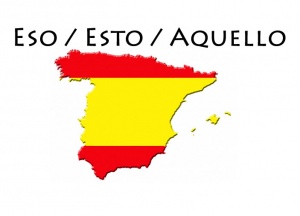Difference between revisions of "Language/Spanish/Grammar/Eso-Esto-Aquello"
m (Quick edit) |
|||
| (7 intermediate revisions by 2 users not shown) | |||
| Line 1: | Line 1: | ||
[[File:Eso-Esto-Aquello-Spanish-Lesson.jpg|thumb | [[File:Eso-Esto-Aquello-Spanish-Lesson.jpg|thumb]] | ||
'''Esta''' lección es para '''aquellas''' personas que tienen problemas con los pronombres demostrativos. | '''Esta''' lección es para '''aquellas''' personas que tienen problemas con los pronombres demostrativos. | ||
<blockquote>This lesson is for | <blockquote>'''This''' lesson is for '''those''' who have problems with demonstrative pronouns.</blockquote> | ||
=What are they?= | =What are they?= | ||
| Line 38: | Line 36: | ||
(Using a formal conjugation) | (Using a formal conjugation) | ||
===Examples=== | |||
*"Aquella señora es mi abuela." | *"Aquella señora es mi abuela." | ||
| Line 45: | Line 45: | ||
*"¿Aquello es un avión?" | *"¿Aquello es un avión?" | ||
<blockquote>Is that a plane?.</blockquote> | <blockquote>Is that a plane?.</blockquote> | ||
==Rules for his use== | ==Rules for his use== | ||
"Esa/Ese | Aquel/Aquella" is used forː | |||
*An identified object, named in the sentence, distant. | *An identified object, named in the sentence, distant. | ||
*To point out an object. | *To point out an object. | ||
| Line 54: | Line 54: | ||
Here are basic rules to take in consideration: | |||
"Esta/Este" is used forː | |||
*An identified object, named in the sentence, close. | *An identified object, named in the sentence, close. | ||
"Esto" is used forː | |||
*An object NOT identified, NOT named in sentence, nearby. | *An object NOT identified, NOT named in sentence, nearby. | ||
"Eso" is used forː | |||
*An object NOT identified, NOT named in sentence, far. | *An object NOT identified, NOT named in sentence, far. | ||
"Aquello" is used forː | |||
*An object NOT identified, NOT named in sentence, distant with formal use. | *An object NOT identified, NOT named in sentence, distant with formal use. | ||
==Other Lessons== | |||
* [[Language/Spanish/Grammar/Simple-Present-Tense|Simple Present Tense]] | |||
* [[Language/Spanish/Grammar/Los-Articulos|Los Articulos]] | |||
* [[Language/Spanish/Grammar/Plural|Plural]] | |||
* [[Language/Spanish/Grammar/El-Verboide|El Verboide]] | |||
* [[Language/Spanish/Grammar/Possessive-Pronouns|Possessive Pronouns]] | |||
* [[Language/Spanish/Grammar/Los-pronombres-personales|Los pronombres personales]] | |||
* [[Language/Spanish/Grammar/Be-Polite|Be Polite]] | |||
* [[Language/Spanish/Grammar/Tener|Tener]] | |||
* [[Language/Spanish/Grammar/Plurals|Plurals]] | |||
* [[Language/Spanish/Grammar/Prepositions|Prepositions]] | |||
<span links></span> | |||
Latest revision as of 13:33, 25 March 2023
Esta lección es para aquellas personas que tienen problemas con los pronombres demostrativos.
This lesson is for those who have problems with demonstrative pronouns.
What are they?[edit | edit source]
These pronouns are useful for referring to an object or person, and show the distance between you and the object. In Spanish it is very important to remember each one to have a good communication.
Esa / Ese / Eso.[edit | edit source]
This pronoun is used to referring to an object which is far.
- "Esa/s" is for feminine objects or women.
- "Ese" is for masculine objects or a man.
- "Eso" is for undefined objects or like plural of "ese" (Esos).
Examples[edit | edit source]
- "Esa casa es roja."
That house is red.
- "Ese hombre me ha golpeado."
That man has hit me.
- "Eso de allí es extraño"
That object from there is strange.
Esta/ Este / Esto.[edit | edit source]
This pronoun is used to referring to an object which is near.
- "Esta/s" is for feminine objects or women.
- "Este" is for masculine objects or a man.
- "Esto" is for undefined objects or like plural of "este" (Estos). "
Examples[edit | edit source]
- "Esta mujer a mi lado es mi esposa."
This woman by my side is my wife.
- "Este maletín contiene dinero."
This briefcase contains money.
- "Esto lo encontré en mi casa."
I found it in my house.
Aquella / Aquel / Aquello.[edit | edit source]
It's the same as "Esa / Ese / Eso" but it's a little bit more formal or used in some countries in remplacement of "Esa / Ese / Eso ".
(Using a formal conjugation)
Examples[edit | edit source]
- "Aquella señora es mi abuela."
That lady is my grandmother.
- "Aquel es el edificio es el cuartel de policía."
That is the police department.
- "¿Aquello es un avión?"
Is that a plane?.
Rules for his use[edit | edit source]
"Esa/Ese | Aquel/Aquella" is used forː
- An identified object, named in the sentence, distant.
- To point out an object.
Here are basic rules to take in consideration:
"Esta/Este" is used forː
- An identified object, named in the sentence, close.
"Esto" is used forː
- An object NOT identified, NOT named in sentence, nearby.
"Eso" is used forː
- An object NOT identified, NOT named in sentence, far.
"Aquello" is used forː
- An object NOT identified, NOT named in sentence, distant with formal use.
Other Lessons[edit | edit source]
- Simple Present Tense
- Los Articulos
- Plural
- El Verboide
- Possessive Pronouns
- Los pronombres personales
- Be Polite
- Tener
- Plurals
- Prepositions
